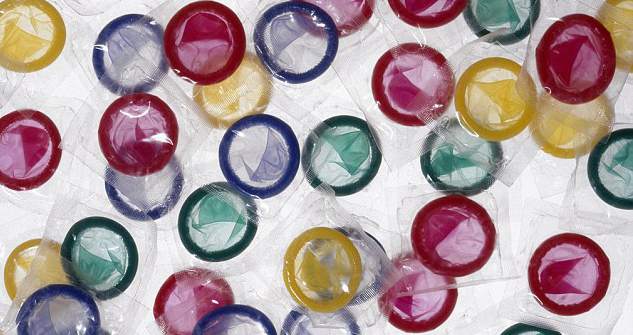Giving out free condoms at school is not a surefire way to avoid teenage pregnancy - or it might not be enough.
在校园里发放免费避孕套并不是一个防止青少年怀孕的稳妥之法--或者说这可能还不够。
Access to condoms in schools increases teen fertility rates by about 10 per cent, according to a new study by the University Of Notre Dame.
圣母大学的一项最新研究表明,在学校里能够获得避孕套的情况下,青少年们的生育率提高了10%。
However the increase happened in schools where no counseling was provided when condoms were given out - and giving out guidance as well as birth control could have the opposite effect, economists Kasey Buckles and Daniel Hungerman said in the study.
在这份研究中,经济学家凯茜·巴克尔斯和丹尼尔·亨格曼表示,生育率有所上升的学校在发放避孕套的时候没有提供咨询服务,而在提供生育控制措施的同时提供指导会起到正面的效果。
Access to other kinds of birth control, such as the contraceptive pill, IUDs and implants, has been shown to lower teen fertility rates - but condoms might have opposite consequences due to their failure rate as well as the time and frequency at which they're used.
而其他避孕措施,例如避孕药和植入宫内避孕器,在降低生育率方面确有其效--但是由于破损以及使用时间和次数的原因,避孕套有可能带来相反的结果。

Buckles and Hungerman looked at 22 school districts located in 12 different states, using data from the 1990s. Times have changed already and teenagers today are overall less likely to have sex and less likely to become pregnant, they wrote. Most of the free condoms programs in the study began in 1992 or 1993 and about two thirds involved mandatory counseling.
巴克尔斯和亨格曼在美国12个州的22个学区进行了调查,使用自20世纪90年代以来的数据。随着时间的推移,总体而言,如今的青少年发生性行为次数更少,怀孕几率也更小。研究中涉及的大部分免费避孕套项目开始于1992年或1993年,其中大约三分之二提供强制性咨询服务。
The 10 per cent increased occurred as a result of schools that gave out condoms without counseling, Buckles and Hungerman said. 'These fertility effects may have been attenuated, or perhaps even reversed, when counseling was mandated as part of condom provision,' they wrote. Teenage girls were also more likely to develop gonorrhea when condoms were given for free - and again, the increase happened as a result of schools giving out condoms without counseling. Access to contraceptives in general has been shown to lower teen fertility, Buckles and Hungerman noted, or in some cases had no effect at all.
巴克尔斯和亨格曼表示,青少年生育率上升10%是因为学校发放避孕套但没有提供咨询服务。但是,提供避孕套时提供强制性咨询服务可减弱甚至颠倒这种生育率影响。免费提供避孕套也会提高女生患性病的机率,而这也是学校没有提供咨询服务导致的。总体而言,避孕措施降低了青少年生育率,但在某些情况下并没有任何效果。
But condoms might have a different impact because of several factors, such as the fact that their failure rate is more important than that of other contraceptives. Condoms also rely 'more heavily on the male partner', which is an important factor given that an unplanned pregnancy will have different consequences for each gender, Buckle and Hungerman wrote.
但是,由于失效等种种原因,避孕套可能产生不同的效果。鉴于意外怀孕会给双方造成不同的影响,避孕套也极大地取决于男性一方。使用避孕套的时间也是为什么它的效果与其他避孕措施不同的原因。
Free condom programs in schools could have led to two additional births per 1,000 teenage women so far, Buckle and Hungerman found. This could increase to 5 extra births per 1,000 teenage girls if the country's entire high-school-aged population had access to condoms.
目前,巴克尔斯和亨格曼发现,学校的免费避孕套项目导致每1000名女生怀孕次数增加2次。如果全美的高中生都可获得免费避孕套,将导致每1000名女生的怀孕次数增加5次。
Condom distribution programs could promote the use of condoms over more efficient birth control methods, drive schools to use their resources for condom distribution rather than more effective programs, or might encourage 'risky' sexual behaviors, Buckle and Hungerman wrote. But these findings should be used with caution when reflecting on policy proposals, they added.
此外,避孕法发放项目可能使更多人选择使用避孕套,而不是其他更有效的避孕措施,从而促使学校开展避孕套发放项目而不是其他更有效的项目,这或许也会怂恿“危险”的性行为。然而,巴克尔斯和亨格曼表示,在反思政策建议的时候,因谨慎使用这些研究发现。
Health clinics based in schools that offered contraceptives were shown to significantly lower teen fertility in a 2014 study. 'If health clinics can effectively combine contraception access and counseling, this may lead to very different effects than access alone,' Buckle and Hungerman said.
在2014年的研究中,学校医务室提供避孕药极大地降低了青少年生育率。巴克尔斯和亨格曼表示,如果医务室能够有效结合避孕措施和咨询服务,将可能产生与仅仅提供避孕措施非常不同的效果。













